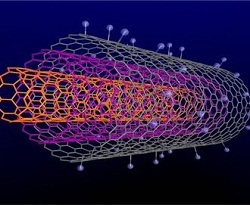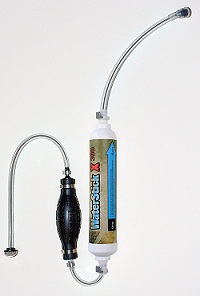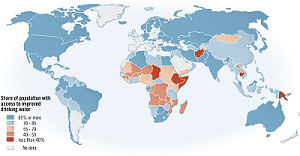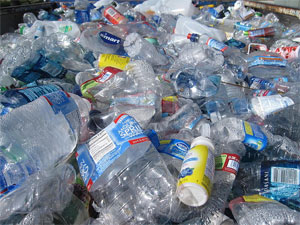The global fresh water supply has become a major concern as most third world nations, and even some developed countries, face the disconcerting reality that drinkable water is running out. To solve this newly realized crisis, engineers are offering the world new, innovative techniques for water purification. Nanotechnology, technological development on the nanometer scale, is a constantly developing scientific field that promises revolutionary water filtration methods and products. Engineers have recently introduced water filters that use carbon nanotubes to clean water, providing a cost effective filtration method that is more successful and portable than traditional filtration techniques.
World: “Help! We need water!”
Although 70% of Earth is covered with water, only about 1% of it is potable. Considering the current global population of more than six billion, this small portion of fresh water is not sufficient to sustain Earth’s inhabitants. This problem is compounded because water is not evenly distributed across the globe. Canada, for instance, has only 0.005% of the world’s population but 22% of Earth’s fresh water [1]. In light of this, we are now facing a water crisis. This may not seem alarming since there has always been a shortage of clean water, but here are some disturbing facts obtained from the 1999 World Water Day:
- A child dies from a water-related disease every 8 seconds.
- Fifty percent of people in developing countries suffer from one or more water-related diseases.
- Eighty percent of diseases in developing countries are caused by contaminated water.
- Fifty percent of people on Earth are deprived of proper sanitation due to lack of water [2].
The problems have only magnified since 1999, and looking at current trends, it is clear that the water shortage is going to worsen drastically (see Fig. 1). According to BBC News, “one person in five has no access to safe drinking water.” In Mexico City, the excessive amounts of water being pumped from its foundations to be used for drinking is slowly causing the city itself to sink. Even more alarming is that a United Nations report predicts that water will be the single biggest cause of conflict and war in the African and Middle Eastern regions in the future [3].
As the water crisis threatens to grow into a global power struggle, there are various groups attempting to develop water conservation and optimization methods to prevent future tragedies. So while some politicians continue squabbling over rivers and lakes, engineers are coming up with better, more advanced technologies to provide cleaner water for all.
Engineers: “We are here to help”
Before the development of the new purification techniques, most decontamination technology revolved around “older” methods like filtration, ultraviolet disinfection, desalinization, electrodialysis, and chemical treatment. The most common of these is filtration, whereby an object, usually a screen or membrane, is used to remove particulate solids from the desired liquid. Types of filtration methods include slow sand filtration, carbon filtration, and micro-ultra filtration.
Engineering, however, has yielded other, more advanced, purification techniques, including electrodialysis, which owes much of its existence to electrical engineers (a change since most filtration techniques are the result of mechanical and chemical engineering endeavors). Electrodialysis employs an “electric current and special membranes that are permeable to ions, based on their charge” [4]. Basically, this technique uses electric potential to drive positive and negative ions of dissolved salts through special membrane filters leaving clean water behind.
With so many options, it is important to remember that application often defines the desired purity and method by which water is purified. For example, water used in the rinsing steps of integrated circuit fabrication has to be “ultrapure,” requiring the use of particular ultra-filters in order to achieve the appropriate purity level [5]. Although current water purification methods are proven to be effective, engineers are constantly looking for better and cheaper techniques and products to provide clean water.
Improvements in nanotechnology have led to new water purification techniques that have proven to be more efficient than the traditional methods outlined above. Although nanotechnology is a powerful tool that has enabled man to achieve ground-breaking scientific achievements, many people are still oblivious to what nanotechnology really is. Simply put, nanotechnology refers to technological developments on the nanometer scale, a nanometer defined as one millionth of a millimeter [6]. The integration of nanotechnology in the area of water purification has prompted the development of large-scale industrial facilities.
Providing Water for Millions
A water treatment plant can provide purified water to hundreds of thousands of residences. Although the public largely takes it for granted, the ability to provide such massive amounts of clean water is truly an engineering marvel. With the revolutionary application of nanotechnology to water treatment processes, the lives of humans – at least those who live close to nanofiltration facilities – are bound to be impacted.
Auvers-sur-Oise, north of Paris, is the location of the world’s first nanofiltration facility for drinking water. Due to the lack of groundwater, two million Parisians depend mostly on water from the three major rivers surrounding the city – the Seine, the Oise, and the Marne. Traditionally, the purification of river water has involved the injection of positively charged aluminum salts. These salts attract negatively charged floating matter – like metal to a magnet – bringing floating matter to the bottom of the tank. After a series of filtration and ozonization (a taste improvement technique) processes, chlorine disinfectant is added to the water to kill remaining bacteria [7].
The same procedures are performed at the beginning of the nanofiltration process. Following the injection of positively charged aluminum salts and the ozonization process, water is filtered through anthracite and sand filters with holes of 1.2 and 0.8 square millimeters. A nitrification process that removes ammonia from the water follows, accompanied by microfiltration through membranes with openings of about five microns in diameter.
After this micro filtration, the water purification process shrinks to the nano scale. Water is pushed through polymer membranes with holes under one nanometer in diameter (see Fig. 2). Since high pressure is needed to push water through the membranes, pumps are present to create the necessary 8 to 15 bars of pressure. Finally, the nanofiltered water is disinfected with ultraviolet rays [7].
Efficiency vs. Cost Effectiveness
Aside from the technical innovations required to sustain the production of clean water, engineers must also consider the economic feasibility of their technological “improvements”. As with most emerging technologies, price often determines how quickly such improvements will be implemented, if at all. Since many of these new water treatment systems require large facilities and more advanced technology, their realization is often hindered. For example, because of increased energy consumption, water produced at the nanofiltration facility in Auvers-sur-Oise is 60% more expensive than that produced traditionally [7].
Unfortunately, because of this cost, the subpopulations that are in the greatest need for these technologies most often cannot use such techniques. Regions like sub-Saharan Africa and much of Asia simply cannot afford to build such large water treatment facilities, making the goal of providing these technologies even more difficult. This demand for a low cost method of providing potable drinking water has resulted in some additional innovation by many engineers, bringing about unique solutions catered to different societal and environmental needs.
Revolutionary Technology
Recently, a group of engineers from Seldon Laboratories in Vermont developed an exciting new technology that reliably removes lead, arsenic, bacteria, viruses, and even airborne pathogens from fluids without the use of heat, ultra-violet light, pressurized equipment, or chemicals. The engineers introduced the use of carbon nanotube technology that purifies water to a degree that meets, and even exceeds, the Environmental Protection Agency’s (EPA) stringent demands [8].
The product they designed is surprisingly small for a device that can remove such a wide array of hazardous materials and microorganisms (see Fig. 2). Shaped like a tube of toothpaste, the device is 11” by 2” and weights 1.1 pounds, making it highly portable [9]. These portable water purifiers cost millions less than industrial facilities and require almost zero upkeep, effective eliminating the restriction caused by the high cost of large scale purification environments.
The real novelty in this technology, however, lies in its simplicity of use. Imagine this scenario: you are lost in the Amazon jungle and you are carrying a handy carbon nanotube purifier with you. You happen to be thirsty, but the water in a pond close by appears filthy. You fill the top tube of the purifier with the filthy water from the pond while you suck on the bottom tube. Voila! You are thirst-free, and you can be confident that the water you just drank is clean and safe. While to you it seems as simple as dirty water in, clean water out, a remarkable engineering feat is actually taking place in the five inches between the top of the device and the bottom.
This new technology is able to destroy all types of bacteria, viruses, and other microorganisms because it takes advantage of recent discoveries in nanotechnology to form a “kill zone” [8]. Founders of Seldon Laboratories have declined to release crucial information on their product, so the mechanism by which the nanotubes have been bound together to form the “kill zone” is a proprietary secret. Although the mystery behind the technology remains, engineers have proven that engineering can offer solutions to a variety of issues faced by mankind: this new innovative portable carbon nanotube water purifier can now save millions of lives – especially in places where water and proper water sanitation are lacking.
Humans and Water
In the twenty-first century we must live by the motto “Every Drop Counts.” Earth’s expanding population combined with the pollution that contaminates much of the usable water supply might soon make leaving the tap running a luxury rather than a privilege. Engineers, however, are hearing the call of billions and are looking for innovative ways to keep the supply of this crucial component for life in check. Moreover, they are doing so in such a manner that brings clean water to those in the undeveloped world, to whom leaving the tap running would not simply be a luxury, but nothing short of unbelievable.
References
[1] “Wetlands Region Distribution.” Natural Resources Canada.. n.d. Web. 21 July 2004. http://cfs.nrcan.gc.ca/regions/lfc.
[2] “Everyone Lives Downstream.” World Water Day 1999. 22 March 2004. Web. 21 July 2004. http://www.worldwaterday.org/wwday/1999/.
[3] “What’s Your Nano IQ?” National Institute of Standards and Technology. n.d. Web. 21 July 2004. <http://www.nist.gov/public_affairs/nanotechquiz.htm>.World Water Crisis.” BBC News. 2004. Web. 19 July 2004. http://news.bbc.co.uk/hi/english/static/in_depth/world/2000/world_water_crisis/default.stm.
[4] “Frequently Asked Questions.” Lenntech. n.d. Web. 18 July 2004. http://www.lenntech.com/water-purification-steps-FAQ.htm.
[5] “Ultrapure Water Criteria.” GE Infrastructure. n.d. Web. 20 July 2004 http://www.gewater.com/library/tp/740_A_Case.jsp.
[6] “Nanotechnology.” Word IQ Encyclopedia. n.d. Web. 20 July 2004. http://www.wordiq.com/definition/Nanotechnology.
[7] Oger, Genevieve. “French Drink Tap Water? Oui, If It’s Nanofiltered.” Small Times. n.d. Web. 18 July 2004. http://www.smalltimes.com/document_display.cfm?document_id=3943.
[8] “Seldon Laboratories Products”. Seldon Laboratories. n.d. Web. 19 July 2004. http://www.seldontechnologies.com/products/.
[9] Kelly, Matt. “Vermont’s Seldon Labs Wants To Keep Soldier’s Water Pure.” Small Times. 2004. Web. 19 July 2004. http://www.smalltimes.com/document_display.cfm?document_id=%207764#seldon.
[10] “Desalination.” Encyclopaedia Britannica Online. 2004. Web. 22 July 2004. http://search.eb.com/eb/article?eu=30526.






